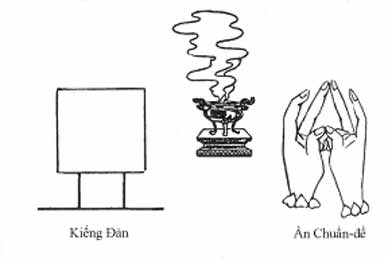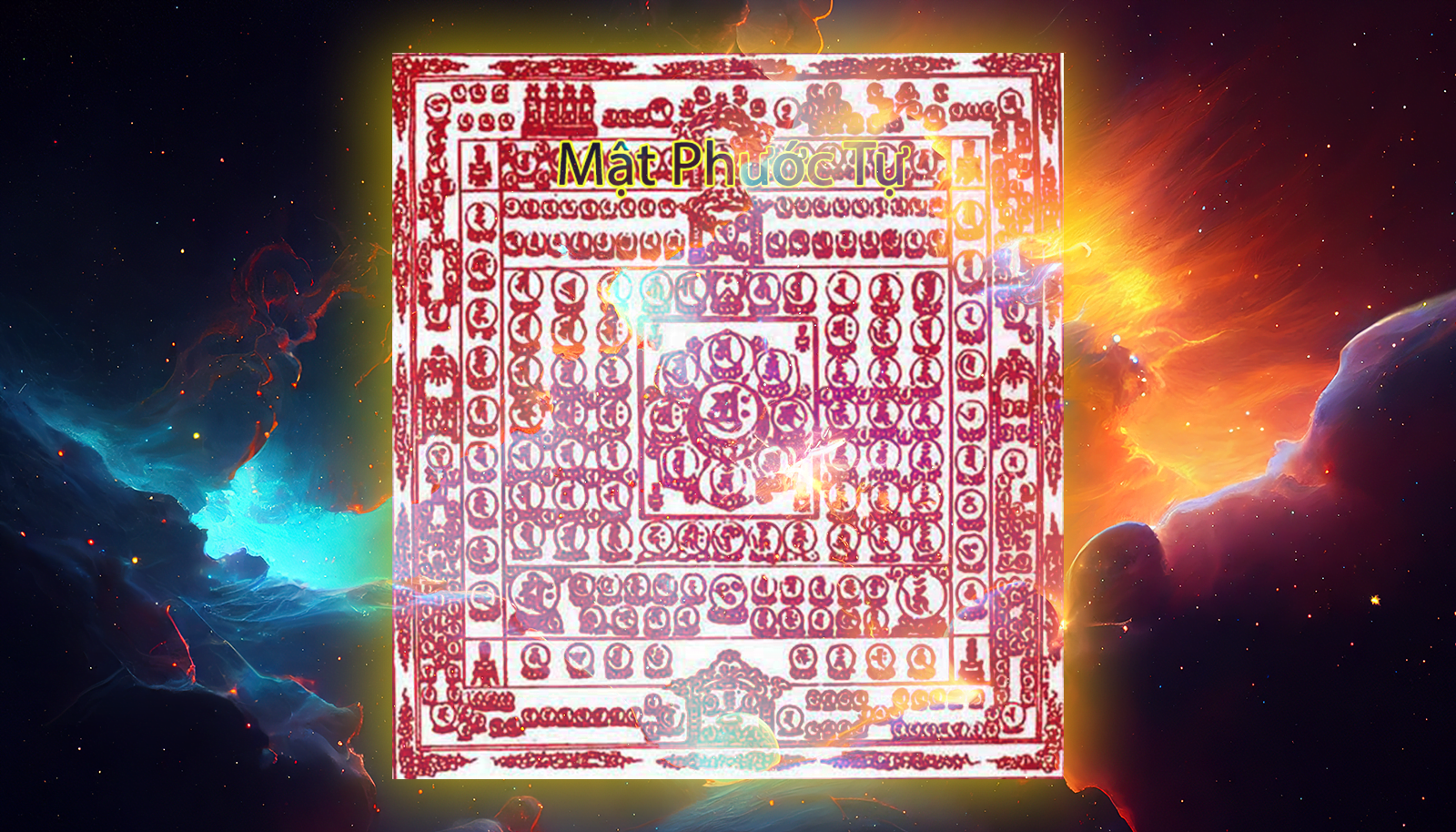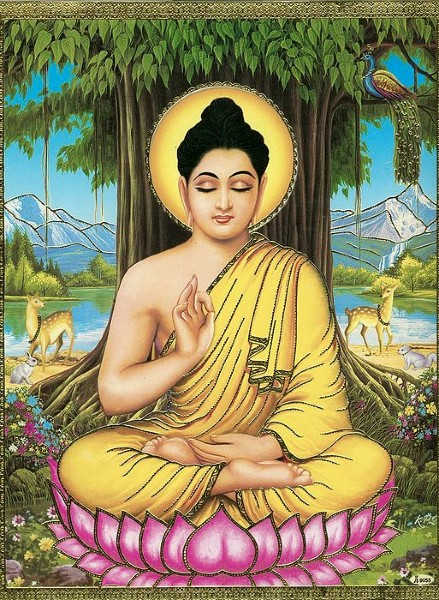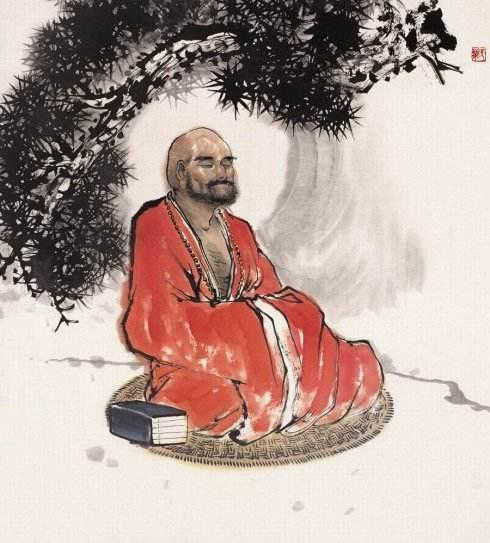Secret Buddhism teachings are similar to any other teachings of Buddhism.. It has 2 aspects: Theory and Practice. In terms of secret sect, it is the Form of Teaching and the Form of Application. The Form of Teaching is the deep meaning behind the Form of Application as taught by the Buddhas and Bodhisattvas. The Form of Application includes practices in mantra chanting, forming Mudras, altar setting and offerings. One must follow strict rules and cannot do whatever comes to mind in performing the rituals.
The disciple of the Way should study both aspects without giving more importance to either one. Without studying the teaching, one cannot understand the meaning of the application to perform correctly. Without studying the application, everything becomes pure theories. The doctrine can be learned from books and from Sutras but a guru or a master of Secret Buddhism must teach the application.
Beside daily routine practice, essential practice of Secret Buddhism is the meditation on the Three Secrets. There are many different meditation techniques based on the level of each person and their preference. However, all secret meditation techniques emphasize focusing on the spirit of the Bodhisattva’s vow before allowing one to choose his own method. That is why thorough knowledge of the precepts and the ability to eventually keep all of them are beneficial to the yogi.
I. The Precepts
During his time on earth, Buddha formed many precepts to teach people with various capacities. When Buddha entered Nirvana, his disciple Upali stood up to read the Buddha’s precepts to the first council gathered there to collect the Buddha’s scriptures.
Later on, the original Buddhism gradually divided into many sects. Each had their own book of laws that were primarily based on the four major precepts and the three groups of precepts to cultivate purity. (Precepts on rites, good deeds and being beneficial to others.)
According to Buddhism, karmas determine our lives. There are three kinds of karmas: action, word, and mind. Keeping the precepts helps purify karma. There are many precepts for different levels of cultivation, from beginning to advance such as: The Forbidden Five, the Eight Rules For Vegetarian, the Ten Good Actions, 250 Rules for the Bhiksu (monk), 350 for the Bhiksuni
(nuns), and the Great Precepts or the Boddhisattva Precepts. Passive and self-serving precepts used to avoid sins belong to the Small Vehicle School. They are: The Forbidden Five, the Eight Rules for vegetarian, the precepts for the Sadi and Sadini (beginners) Bhiksu, and Bhiksuni.
Active and altruistic precepts belong to the Great Vehicle School. They are the precepts for Bodhisattva mentioned in the Brahma Net Sutra; the three groups of Precepts For Cultivation of Purity belong to Great Precepts of other sects.
A. THE FIVE FORBIDDEN PRECEPTS AND THEIR PRACTICAL BENEFITS.
1. No killing of living species. This precept helps one avoid cruelty, helps one stay out of jail in one’s lifetime, or fall in the evil paths (hell, hungry ghost and beasts realms) in the next life.
2. No Adultery. This precept helps one avoid conflicts between families, scandal or fights brought by jealousy.
3. No stealing. This precept helps one avoid jail in one’s lifetime and karmic retribution in the next life.
4. No lying. This precept helps one avoid contempt from others and helps one to have more intelligence.
5. No gambling, smoking, drinking. This precept helps one avoid getting in debt and have savings. It helps one avoid sinful actions when he is intoxicated and helps him avoid contempt from others.
B. THE EIGHT RULES FOR VEGETARIAN.
They are the above Forbidden Five plus these three:
– Not to sleep on a beautiful, luxurious bed.
– Not to play music or listen to opera.
– Not to use adornments or perfume.
These are the 8 precepts that the Buddha had for lay disciples to practice just as the monks.
C. TEN PRECEPTS (for Sadi and Sadini).
The above 8 plus these two:
– Not to have gold, silver and money.
– Not to eat at the wrong time.
The 10 precepts are the foundation for the one entering monk hood. They must work on good deeds to eliminate bad action.
The five, eight, ten precepts belong to the Small Vehicle. The first four: killing, stealing, sexual misconduct, and lying are serious unpardonable offenses by the Small Vehicle. The Great Vehicle allows redemption through repentance from the doctrine of the Middle Way.
Drinking is another basic precept as it causes one to break the other four. The Forbidden Five are fundamental precepts for lay people as well as monks, and for both Small and Great Vehicle.
D. PRECEPTS FOR BHIKSU AND BHIKSUNI.
-Parajika: (4 precepts for monk; 8 precepts for nun)
Breaking of these 4 precepts: killing, stealing, sexual misconduct and lying result in banning from Buddhism.
-Sanghavasesa: (13 precepts for monk; 17 precepts for nun)
Breaking these rules is compared to having damaged one’s five sense organs.
-Nissaggya: (120 precepts for monk; 208 precepts for nun).Breaking one of these rules results in hell after death.
-Patidesaniya: (4 precepts of monk, 18 precepts for nun).Breaking one of these rules can be redeemed. Repentance is allowed by confessing to another monk.
-Dukkata: (100 precepts for monk; 100 precepts for nun).
There are so many precepts; most are trivial ones that need to be observed every hour and minute of the day.
E. BODHISATTVA PRECEPTS-OR THE MAHAYANA PRECEPTS FROM THE BRAHMA NET SUTRA (10 major and 49 minor ones).
The Ten important ones are:
1. Not to kill for pleasure.
2. Not to steal or rob.
3. For monk: Not to have sex. For lay disciple: Not to commit adultery.
4. Not to lie with intention to harm.
5. Not to buy or sell alcohol.
6. Not to talk about others’ errors.
7. Not to praise oneself and put down others.
8. Not to be difficult in giving out the Dharma and insult the one who ask for it.
9. Not to be angry and refuse to listen to advice.
10. Not to offend the triple Jewels (Buddha, Dharma and the monks).
Breaking one of these ten rules is a serious offense. Breaking one of the forty-nine minor rules is pardonable.
Breaking one of these ten rules is a serious offense. Breaking one of the forty-nine minor rules is pardonable.
F. MAHAYANA PRECEPTS OF THE SECRET SECT.
(Revelation of Magic Principles Governing Bodhi Heart Bodhisattva Precepts)
In central India country of Magadha, Rajagraha City, at the Nalanda Forest of Bamboos monastery, there was a Tripitaka monk named Dubaca, or Subhakarasimha. He was from a generous and noble family of Ksatrya lineage, an expert in the doctrine of the Great Vehicle. When he came to China, he discussed the Great Vehicle in depth and analyzed its essential points with Zen master Jing Xian an at the monastery Hui Shan in Cong Yue. The dialogue of Dubacala has opened the people’s eyes and converted them to Buddhism. His exposition contains the requirements to receive the Revelation Of Magic Principles governing the Bodhi Heart Bodhisattva Precepts of the Secret Doctrine, which has been transferred up to this day. The following is a general outline.
1. The subject on paying homage.
2. The subject on offerings.
3. The subject on repentance.
4. The subject on taking refuge with the Buddha.
5. The subject on making the Bodhi Vow (Vow to become Buddha).
6. The subject on protection from dangers.
7. The subject on respectfully inviting the master. 8. The subject on the supernatural doctrine.
(Three groups of precepts on cultivation of purity: precepts of rites with its 10 precepts to avoid cruel actions, precepts on good action and precepts on being beneficial to others).
9. The subject of keeping the precepts.
10. The subject of cultivation of the four salvations.
11. Ten Major precepts (just for Secret Buddhism).
II. Appendix
Although the practitioner has received the Bodhisattva precepts, it is better that he also receives the precept and doctrine on the awakening of the heart of purity and the passionless nature of Buddhas to enter the gate of samadhi. This doctrine on precepts is itself the secret Dharani that Buddhas has used to come to the sea of “All Knowing Mind”. It has been kept secret so far. The following are some of the essential revelations for the person that has affinity with the secret doctrine.
First Dharani: (……)
Reciting this Dharani 3 times allows entrance to the forbidden peaceful realm and to listen to other secret doctrine and all the rules governing the serenity of Bodhisattva.
Second Dharani: (……)
Reciting this Dharani 3 times 108 (324) allows one to make the vow to reach enlightenment and to become Buddha without fail.
Third Dharani: (……)
Reciting this Dharani 3 times 108 allows one to get all the precepts and the wisdom of Buddha.
Fourth Dharani: (……)
Reciting this Dharani 3 times 108 allows one to attain the rank of Abhisekha master. He will be able to understand the secret doctrines. He will be able to receive and practice all the subjects on stillness.
(Subhakarasimha Tripitaka On Receiving The Precepts Of Redemption And Essential On Meditation)
III. THE PRACTICE OF THE FIVE ESSENTIALS DHARANIS.
First stage: Recite the Dharani for 100 days. (Each session 108 times)
Second stage: Recite the Dharani for one year (each session 5×108=540 times)
Third stage: Recite the Dharani for 3 years 3 months 3 days (each session 5×108= 540 times.)

On the 15th day of the Lunar month, stand in front of Buddha’s statue and a mirror that has never been used, form the Cundi Mudra and recite 108 times the five groups of Dharani.
Next, sit in the full or half lotus position in front of the mirror substituting for the Mandala and silently pray as dictated by the rituals of Secret Buddhism.
A. RITUALS TO PAY HOMAGE TO THE BUDDHAS IN TEN DIRECTIONS, AND THE TRIPLE JEWELS (Buddha, Doctrine, Sangha).
1. I sincerely pay homage to Mahavairocana Buddha (the Creator) (1 bow)
2. To the blissful Precious Body of Vairocana (1 bow)
3. To all the Buddha’s Incarnate Bodies (1 bow)
4. To all the miraculous Dharani Doctrine (1 bow)
5. To all the Bodhisattvas having both Blessings and Wisdom as numerous as the waters in the ocean. (1 bow)
B. THE FIVE-DHARANI RECITATION.
Form the Cundi Mudra and silently recite the full Dharani 108 times:
Om Ram. Om Shirum. Om Mani Padme Hum. Om Cale Cule Cundi Svaha. Brum.
C. OFFERINGS THE MERITS FROM RECITING DHARANI.
1. Prayer For A Peaceful Rebirth.
To the Triple Jewels and the majestic Deities who support the one who prays, the Bodhisattvas and Shravaka, Brahma Indra Tchaturmaharaja, the eight fold division of Deva Naga, the Dharma protector, the King of the Deities, and to all compassionate Gods, please acknowledge that as a disciple, I sincerely recite Dharani and wish to offer these merits to all the souls that have died from injustice or from sudden death, and to those who wandered in the mountain and forest or desolated villages to be liberated and reborn in the Pure Land of the Buddhas.
2. Secondary Prayer.
As a disciple, I pray to eliminate bad karma. I pray to banish all evil spirits, cruel ghosts and Demons, all attachments, separations illusions and delusions, all the spells, diseases and accidents.
3. General prayer.
I pray for safety and peace in all four seasons, for abundance in the world, for more blessing and intelligence and for the fulfillment of my wishes.
Namo PUNYATARA Bodhisattva.
(Chinese: Gong De Lin Bodhisattva- The Boddhisattva whose merits are as numerous as the trees in the forest)
(Reciting 3 times, bow down 3 times)
IV. SEVEN KINDS OF MEDITATION IN SECRET BUDDHISM:
Research on meditation from different religions, schools of philosophies, or from various sects, reveals an exciting, but difficult subject that surpasses the scope of this book. However, the main methods of meditation of the Great Vehicle can be summarized in the following seven groups.
1. Meditation by observation of the breath.
According to the Oneness Principle of the Heart and Breath, if we can control the breath, we can harmonize the heart. The practice ..led breathing is the best method to enter Samadhi. The most common method is counting the breath, following or holding one’s breath. The first method is safer and easier. Zen masters strongly recommend this method, which was practiced over centuries. With this method one does not have to depend on the guidance of a Guru if he understands basic breathing techniques and principles of Yoga.
Monk Zhi Kai, the first founder of the Tien Tai sect of China explained the “counting and following” breathing technique in his famous book “The Gate To The Six Wonderful Doctrines” (or Six Wonderful Ways To Enlightenment).
2. Onepointedness Yoga.
This method looks simple, but is in fact difficult. Many Gurus advise that first and foremost, the practitioner must be somewhat skilled in the breathing technique before starting this method; otherwise, he will feel that this is too difficult, and will become frustrated. The practice ..ing on an object in front of the practitioner is safer, but not as effective as to focus on a certain point of the body. This latter method definitely leads to extraordinary unusual results, and a special spiritual experience. For instance, focusing on the middle of the eyebrows gives the experience of light, and focusing on the navel gives the experience of serenity and happiness. Focusing on the heart summons all active energies together and lead to the experience of peacefulness. The experts in Secret Buddhism confirm that every center in the five psychic points (Chakras) of the body has its special function and effectiveness that only a proficient guru can thoroughly explain. Detailed documents on this subject can be found in the literature of Tibetan Secret Buddhism.
3. Visualization Yoga.
One of the best methods to control the mind and one’s energy is visualization of an image with closed eyes. This is difficult because the image is constantly moving and blurred. Secret Buddhism specially emphasizes its usefulness and applies it in almost every form of meditation. There are hundreds of ways of visualization for different purposes and applications. At the beginner level, one learns to focus and concentrate on an object that is outside of the body and create a mental picture of it. A higher level is to visualize an object orbiting in a limited area in the body. It is best for the beginner to focus on a detailed image as a way to train his wandering mind and for the advanced to focus on a simpler one. Highly advanced practice consists of mentally holding the image of a very large object in a tiny space. Many Tibetan practitioners can visualize a large Mandala within a small pea. Therefore, visualization can stimulate vivid hidden potentials of the mind and can lead to a higher state of Samadhi.
4. Mantram Yoga (chanting of mantra or Magic Formula).
The practice of visualization uses the mind’s eyes in meditation. Mantram yoga uses the mind’s ears. Either sound or sight could lead to Samadhi. The chanting of a prayer or mantram, calling upon a Buddha’s name or the chanting of a single sacred word as “Om” or “Ah” is widely practiced in the East. Although Buddhism does not emphasize the importance of sound as much as Hinduism, the Yoga of sound has always been one of the pillars of meditation in Buddhism. It was widely practiced by monks and layworshipper at all levels. Its popularity is due to these three reasons: It is easy and safe, it is based on faith, and it satisfies the need of religion for the mass.
5. Physical Yoga.
Generally speaking, the most direct method among others to achieve Samadhi is the meditation on stillness. However it is not the only method. There are certain kinds of exercises that can also lead to Samadhi, such as the famous Tai Chi Chuan from China, invented by Zhang San Feng, a great master in the Ming dynasty. It is a wonderful practice and can be compared to the uniqueness of Shao Lin Kung Fu of Secret Buddhism. Theses practices stimulate infinite power within the individual. The immortals and saints revealed these martial arts which are a very gentle practice, ingeniously designed to bring one’s passive and active energies into full harmony, resulting in peaceful feelings and leading to Samadhi.
There is another special method of meditation created by religious masters. With this practice, the practitioner wakes up his Kundalini (source of energy) in a few days, with special movements of his two thumbs. This movement is kept secret and is mysteriously revealed to the practitioner when he achieves a certain level of spiritual advancement.
Generally speaking, Buddhism does not emphasize this method in meditation. However, Buddha not only did not reject its usefulness, he used it under certain conditions as a very good way of auxiliary practice.
6. Contemplation Yoga.
This is the most important of the five spiritual meditation practices mentioned above. Many Buddhists practiced the doctrine of “The Four Countless Virtues” to nurture good thoughts for all, and to reduce conflicts that cause misfortunes between men. This practice must come first before one attempts any other methods. In Tibet, the hymns on “The Four Countless Virtues” are recited and meditated upon prior to any practice. The lack of spiritual preparation, training on good thoughts and adoration, will not bring any good results for any kind of meditation. It can even lead to the wrong way. Practitioners who do not achieve enlightenment after a long period of meditation will find out that they are lacking in spiritual cultivation. They will then return to the basic practice of “The Four Countless Virtues”, the Bodhisattva’s Vow, and the use of prayers, prostration and adoration to complement their practice. This is the basic practice for anyone who is serious in reaching enlightenment.
7. Self Realization Yoga
This is the so-called undemanding meditation practice of the Zen and MahaMudra sects. It is a meditation that has nothing to focus on. It is the sudden and wonderful response of the mind, the essence of all doctrines. For the ones who have not yet entered its door, this is the most difficult way. But for those who have entered, it is the easiest way. All other practices are only preparations for this one. The essence of this practice is to gain insight into the true nature of the mind, to realize the nature of the mind, or to at least catch a glimpse of it. Once it is known, one can easily identify with it at anytime and place. In action or in quietude, the consciousness of extreme perfection is ever shining. Even though there is still a long way to go following the realization of self, the sages of Buddhism considered this first realization most important. Once a practitioner enters the “Gateless Gate”, meditation is no longer a practice or effort but is as natural as life itself. To obtain this “Gateless Gate” stage we must diligently practice this meditation by following the way of Zen, or the way of MahaMudra sect. (Tibetan Book of the Great Liberation and Tibetan Book Yoga and Secret Doctrine Book, Volume II of Evans-Wentz).
Related Post

Heaven’s Plan (By Mysticism Scholar Duc Quy)
Heaven's Plan (By Mysticism Scholar Duc Quy) (Thiên cơ cư sĩ Đức Quý by Lĩnhnam on Oct 15, 2011 11:23...

The Miraculous Tree of Tsong Khapa
The Miraculous Tree of Tsong Khapa Linh thụ Tây Tạng; by Dianichi on Sun Nov 23, 2008 10:27 am. The...

Chapter VI: V & VI – The Cundi Dharani spoken by the Mother of Seven Kotis Buddhas
V. The Cundi Dharani spoken by the Mother of Seven Kotis Buddhas Tang Dynasty, India, Tripitaka master Amoghavajra translated from...

Foreword
Foreword: This book, "Mysticism in The Investiture of the Gods" is a translation from the original Vietnamese text. The Chinese...

Story 5 – Magical Skull practice and Explanation
Story 5 - Magical Skull practice and Explanation Câu chuyện số 5 - Thiên linh cái và lý giải by...

THE DRAGON’S JADE PEARL
THE DRAGON'S JADE PEARL Ngọc Long Châu by Bạch Hạc on 07 May 2016, 11:53 - translated by Horangi. I...

DIVINE DRAGON: HEAD HIDES ENDLESS TAIL
Why doesn't the Buddha appear to save humanity? Divine dragon: head hides endless tails depicts an immensely grand divine entity...

JADE DIAMOND SEAL AND THE MAGICAL SWORD
JADE DIAMOND SEAL AND THE MAGICAL SWORD (NGOC TỶ KIM CANG ẤN VÀ LỤC YỂM THẦN GƯƠM by Lĩnhnam on...


